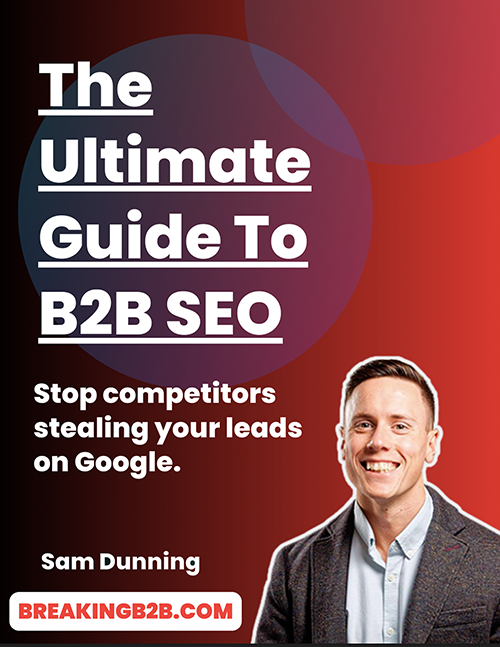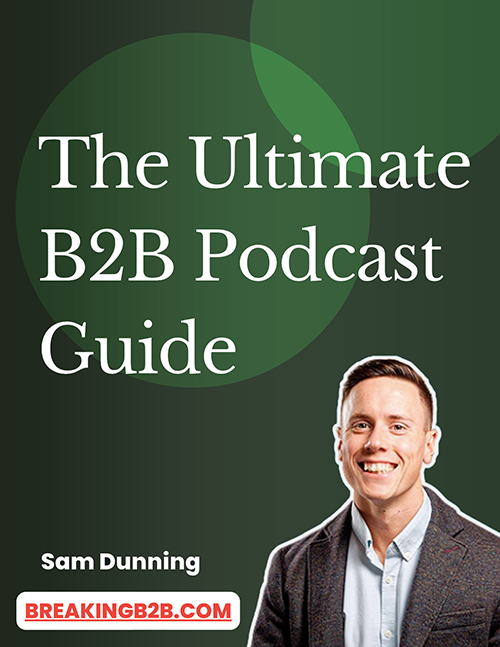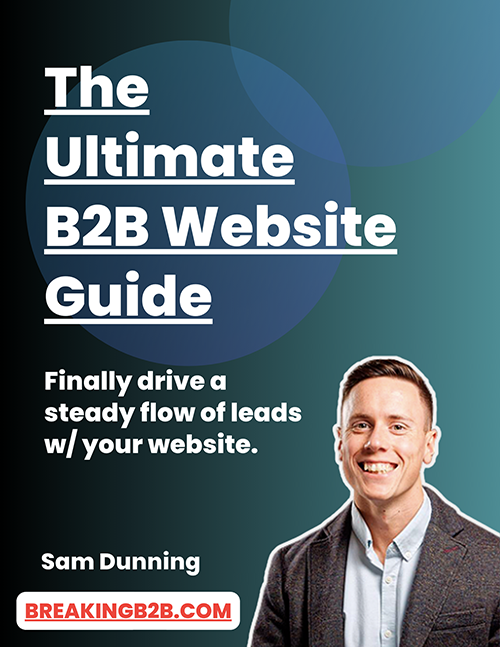SaaS Technical SEO Guide
For Unmatched Growth!
Author: Sam Dunning ✪ Date: June 17th 2024
In today's digitally-driven marketplace, Software as a Service (SaaS) companies must leverage every possible advantage to stay ahead of the competition. One of the most powerful tools in their arsenal is SaaS technical SEO, an often-overlooked aspect that can significantly impact their growth trajectory.
Unlike traditional SEO, which focuses on content and keywords, technical SEO focuses on your website's backend mechanics. The stakes are high: according to BrightEdge, organic search drives 53.3% of all website traffic, underscoring the importance of a robust SEO strategy.
For SaaS companies, this means that a well-optimised website can be the difference between exponential growth and stagnation. In this
comprehensive SaaS technical SEO guide, we'll walk you through the essential technical SEO tactics tailored specifically for SaaS platforms.
Also be sure to checkout my
SaaS SEO Essential checklist for more Proven Strategies for Explosive Growth!
Why SaaS Technical SEO is Important
SaaS technical SEO ensures your website's structure and content are optimised for search engines.
When you focus on a solid technical SEO strategy, you lay the groundwork for better search engine ranking, which directly impacts your organic traffic. The backbone of this strategy is your website structure. A well-organised site with clear URL hierarchy and XML sitemaps helps search engines understand and index your pages efficiently.
Moreover, a properly optimised website improves user experience. Think about it: faster page loading speeds and mobile responsiveness are critical.
Users are more likely to stay on your site and engage with your content if they don't encounter frustrating delays or navigation issues. This, in turn, reduces bounce rates and can lead to higher conversion rates, which is essential for SaaS businesses.
Benefits of Optimising SaaS Websites
Enhancing your SaaS website for technical SEO can significantly boost your search engine rankings, driving more organic traffic to your site. By focusing on SaaS technical SEO, you're not only increasing visibility but also improving user experience.
Well-optimised sites see a 40% decrease in bounce rates, meaning visitors stay longer and engage more with your content. This increased engagement can have a substantial impact on your bottom line.
Site speed is another critical factor. A boost in site speed makes your website more responsive, reducing load times and keeping users satisfied. Faster sites lead to better user engagement and retention, which can directly influence your conversion rates. In fact, implementing technical SEO for SaaS can increase conversion rates, driving more leads and revenue.
Moreover, technical SEO helps protect your website from security threats, reducing the risks of data breaches and downtime. This protection ensures that your site remains reliable and trustworthy for users and search engines alike.
Let’s now shift to the SaaS technical SEO tips:
1. Website Architecture & Navigation ✓
Proper website architecture and navigation frequently play a critical role in ensuring users can easily find the information they need. When your site's layout is intuitive, visitors stay longer, reducing bounce rates and increasing user engagement.
Start with clear navigation menus that categorise content logically. This not only helps users but also search engines understand your website structure more effectively.
A logical hierarchy is essential. Organise your pages and categories in a way that flows naturally, from general topics to more specific ones. This structure improves internal linking, which is important for SEO.
2. Mobile-Friendliness & Responsive Design ✓
As you improve your website's architecture and navigation, you must also ensure it's mobile-friendly and responsive to meet modern users' expectations and Google's mobile-first indexing.
Mobile optimisation is essential since more users access websites via their phones. Ensuring your site has a responsive design means it will automatically adjust to various screen sizes, offering a seamless experience across all devices.
Mobile-friendliness isn't just about layout; it's also about functionality and ease of use. Implementing Progressive Web Apps (PWAs) can greatly enhance user engagement by providing app-like experiences directly through the browser.
PWAs are known for their reliability, speed, and user engagement, making them a wise choice for SaaS businesses aiming to retain mobile users.Another critical aspect of mobile optimisation is page loading speed. Faster pages lead to better user experiences and higher SEO rankings.
While we'll dive deeper into page loading speed optimisation shortly, remember that using protocols like HTTP/2 can improve both speed and security on mobile devices.
3. Page Loading Speed Optimisation ✓
Optimising page loading speed is essential for maintaining user engagement and improving your site's SEO performance. When your site loads quickly, users are more likely to stay, reducing bounce rates and increasing conversions. Google recommends a loading time of under 3 seconds, making this a critical metric for your SEO strategy.
To boost your page loading speed, start by optimising images. Compressing images reduces their size without compromising quality. This simple step can greatly enhance both desktop and mobile page loading times.
Also, focus on reducing server response time. A slow server can drastically impact how quickly your pages load. Use a reliable hosting provider and consider a Content Delivery Network (CDN) to distribute content efficiently.
Another powerful tool at your disposal is Google's PageSpeed Insights. This tool analyses your site and offers actionable optimisation tips, such as leveraging browser caching and minifying CSS, JavaScript, and HTML. Implementing these recommendations can lead to noticeable improvements.
4. URL Structure and Hierarchy ✓
A clear URL structure is essential for effective content organisation and SEO optimisation. By categorising your URLs based on your website taxonomy, you create a logical hierarchy that helps both users and search engines navigate your site more easily.
Think of your URL structure as a roadmap. Each URL should clearly indicate the content's position within your site. For instance, using category-based URLs like 'example.com/blog/seo-tips' makes it evident that 'seo-tips' is a part of your blog section. This hierarchical approach improves content classification and boosts user engagement by making it easier for visitors to find relevant information.
Moreover, a well-structured URL hierarchy aids search engines in indexing, crawling, and rendering your pages more efficiently. Properly organised URLs signal to search engines how your content is interconnected, enhancing your site's overall SEO performance.
In short, investing time in refining your URL structure and hierarchy is a key step toward better content organisation and effective SEO optimisation.
5. XML Sitemaps and Robots.txt ✓
To effectively manage search engine indexing and crawling, you need to understand and utilise XML sitemaps and the robots.txt file. XML sitemaps provide search engines with a detailed roadmap of your website's content and URLs.
By submitting an XML sitemap, you guarantee search engine crawlers can efficiently discover new pages and updates, leading to better website indexation. This is important for SaaS websites that frequently add new content or make updates.
On the other hand, the robots.txt file is a simple, yet powerful tool that instructs search engine crawlers on which pages to crawl and index.By clearly defining your crawl behaviour rules in this file, you can prevent search engines from indexing sensitive or irrelevant pages, such as login portals or duplicate content areas.
This helps in optimising your crawl budget and ensures that only the most important pages get indexed.
Using XML sitemaps and robots.txt files together gives you more control over how search engines interact with your site. Proper management of these tools can significantly improve your site's visibility and ensure that your most valuable content is easily accessible by search engines.
6. Title Tags and Meta Descriptions ✓
One of the most effective ways to enhance visibility and click-through rates (CTR) is to optimise title tags and meta descriptions. Though often overlooked, these elements can significantly impact SEO performance.
Title tags are HTML elements that specify a web page's title. They are displayed on SERPs as the clickable headline for a given result and are crucial for both SEO and usability.
Meta Descriptions, on the other hand, are short summaries of a web page's content. Although not a direct ranking factor, they play a significant role in influencing user click-through rates.
Why Title Tags Matter
Title Tags are often the first impression a user has of your website. For SaaS companies, where the competition is fierce and the audience is savvy, a compelling and relevant title tag can make all the difference. Here's why:
- SEO Ranking Factor: Search engines use title tags to understand the content of your page. Well-optimised title tags with relevant keywords can improve your ranking on SERPs.
- User Experience: A clear and concise title tag helps users quickly understand what your page is about, improving their experience and increasing the likelihood they will click through to your site.
- Branding: Including your brand name in the title tag can enhance brand recognition and trust, especially important in the B2B SaaS industry where reputation matters.
The Role of Meta Descriptions
While meta descriptions are not a direct ranking factor for search engines, their importance should not be underestimated:
- Click-Through Rates: An engaging meta description can significantly influence a user's decision to click on your link. For SaaS companies, where the buyer journey is often longer and more complex, capturing interest at the earliest stage is crucial.
- User Expectation: A well-crafted meta description sets the right expectations for what the user will find on your page, reducing bounce rates and improving user satisfaction.
- Differentiation: In a crowded market, a unique and compelling meta description can set you apart from competitors, making your link more attractive to potential customers.
Best Practices for Optimising Title Tags
- Keyword Placement: Place primary keywords the beginning of the title tag to ensure they are not cut off in SERPs.
- Length: Keep title tags under 60 characters to ensure they are fully displayed on SERPs.
- Clarity and Relevance: Ensure the title tag accurately reflects the page's content. Misleading titles can lead to high bounce rates and lower user trust.
Best Practices for Crafting Meta Descriptions
- Persuasive Language: Use action-oriented language that encourages users to click. Phrases like "Learn more," "Discover," or "Get started" can be effective.
- Length: Keep meta descriptions under 160 characters to ensure they are fully displayed on SERPs.
- Unique Descriptions: Avoid duplicating meta descriptions across pages. Each page should have a unique description that accurately reflects its content.
Don't overlook these small yet powerful components of your SEO strategy – they could be the key to your SaaS company's success.
7. Schema Markup Implementation ✓
Implementing schema markup on your SaaS website can greatly enhance how search engines interpret and display your content. Schema markup, a form of structured data, helps search engines understand the specifics of your content, which can lead to more prominent and attractive search engine results pages (SERPs).
By providing detailed information about your services, products, and other relevant data, you can achieve rich snippets, which are enhanced search results that stand out and attract more clicks.
Using schema markup is especially beneficial for improving your site's visibility and click-through rates. Search engines like Google use this data to generate knowledge graph panels, event listings, and other features that make your content more appealing and accessible to users.
To confirm that your schema markup is correctly implemented, utilise the Google Structured Data Testing Tool. This tool helps you validate your schema markup, identify errors, and verify that your structured data is properly formatted and understood by search engines.
Incorporating schema markup not only boosts your SEO efforts but also provides users with a richer and more informative browsing experience. By adopting this practice, your SaaS website can achieve better rankings and higher engagement in search results.
8. Optimising Images and Multimedia ✓
Optimising images and multimedia is crucial to further enhancing page load speed and user engagement.
Image optimisation begins with compressing images, which can decrease load times by up to 80%. Remember to add alt text to your images; this enhances accessibility and helps search engines better comprehend your image content.
Implementing lazy loading is another effective strategy. It guarantees that images are only loaded when they come into view, greatly enhancing website performance.
Additionally, using responsive images ensures your visuals display well across various devices and screen sizes, improving the user experience.
Multimedia optimisation extends beyond just images. Ensure your video and audio files are properly formatted and compressed to reduce loading times. This not only accelerates your site but also keeps users engaged for longer periods.
9. Handling Dynamic Content ✓
Handling dynamic content on your SaaS website is crucial for guaranteeing search engines can effectively crawl and index your pages. Dynamic content often changes based on user interactions or preferences, making it challenging for search engines to manage.
You need to address session-based URLs, as they can complicate search engine indexing and negatively impact your rankings.
To manage dynamic content, consider using dynamic rendering techniques. This approach ensures search engines can crawl and index your content by serving a static HTML version to crawlers.
Additionally, proper use of canonical tags helps avoid duplicate content issues by pointing search engines to the original version of a page.
Incorporating structured data is another crucial step. Structured data helps search engines understand the context and structure of your dynamic content, making it easier for them to index it correctly. This can significantly improve your visibility in search results.
Monitor and update your dynamic content regularly to ensure it remains SEO-friendly. This will keep it accessible to search engines and improve the user experience.
10. SEO for Single-Page Applications ✓
Optimising single-page applications (SPAs) for search engines poses unique challenges, especially with dynamic content loading and ensuring effective crawlability. To tackle these issues, you need to focus on several key technical aspects that will improve your SaaS technical SEO efforts.
- Meta Tags Optimisation: Guarantee that your SPAs have well-defined meta tags for titles and descriptions. This helps search engines understand what each page is about, even if the content is loaded dynamically.
- Server-Side Rendering (SSR): Implementing server-side rendering can greatly enhance the crawl-ability of your SPAs. SSR allows search engines to index your content more effectively, as it's rendered on the server before being sent to the client.
- URL Structure: Pay close attention to your URL structure. Use clean, descriptive URLs and ensure each unique piece of content has its own URL. This makes it easier for search engines to index your pages correctly.
- Internal Linking: Properly manage internal linking within your SPA. Use descriptive anchor text and ensure all important pages are easily accessible from other parts of the site.
11. Managing User-Generated Content ✓
Incorporating user-generated content (UGC) into your SaaS website can greatly enhance your SEO efforts by providing fresh, relevant material that engages visitors.
UGC, like user reviews and testimonials, enriches your site with new content and boosts your SEO rankings. It provides social proof, which increases your credibility and trustworthiness among potential customers.
To effectively manage UGC, monitor it for spam and inappropriate content. This guarantees that your site remains professional and aligns with legal regulations. Encouraging user reviews and feedback can notably improve your search engine visibility, as this content is often rich with keywords and aligns with search intent.
For SaaS companies, leveraging UGC for SEO means optimising this content for relevant keywords.
Make sure user reviews and testimonials are prominently displayed and easy to find. This not only enhances your site's SEO but also provides valuable insights into user satisfaction and areas for improvement.
12. Localisation and International SEO ✓
International SEO for SaaS involves optimising your website to cater to diverse languages, cultures, and search habits.
Integrating localisation into your strategy will adapt content, keywords, and user experiences to specific regions or countries, making your site more relevant and engaging to international users.
To effectively implement multilingual SEO strategies, consider the following:
- Localised Keyword Research
Identify and integrate keywords specific to the target region's language and search behaviour. This step ensures your content resonates with local audiences and ranks well in search results. - Content Optimisation
Adapt your content to reflect cultural nuances and preferences, ensuring it's not just translated but also contextually appropriate for each region. - Hreflang Tags
Use hreflang tags to signal to search engines the language and regional targeting for each version of your content, helping them serve the right content to the right users. - Localised User Experience
Tailor the user interface and experience to meet the expectations and habits of users in different regions, enhancing engagement and satisfaction.
Incorporating these strategies will help your SaaS website thrive in the global market.
13. Conducting a Comprehensive Audit ✓
Performing a thorough SEO audit for your SaaS website guarantees that all technical aspects are optimised to improve search engine rankings and enhance user experience.
Start your technical SEO audit by analysing crawlability and indexation. Tools like Screaming Frog and Google Search Console are invaluable for detecting crawl errors and broken links that can hinder search engine bots from properly indexing your site.
Next, focus on identifying duplicate content. Duplicate content can confuse search engines and dilute your ranking potential. Make sure each page has unique content and use canonical tags to indicate the preferred webpage version.
Optimising meta elements—such as title tags, meta descriptions, and header tags—is essential. These elements help search engines understand your pages' content and improve click-through rates from search results.
Don't overlook the importance of site speed and mobile friendliness. Use tools like Lighthouse to gauge performance metrics and identify areas for improvement.Lastly, keep an eye on your XML sitemap health to ensure all important pages are indexed.
Regular technical SEO audits help maintain your website's health, boost your search engine rankings, and provide a seamless user experience. Addressing these elements will set a strong foundation for your SaaS website's success.
14. Using SEO Tools and Analytics ✓
SEO tools and analytics are essential for optimising your SaaS website and gaining a competitive edge. These resources can help you identify and resolve technical issues, enhance user experience, and boost search engine rankings.
SEO tools like Screaming Frog and Semrush offer in-depth insights into your website's performance, uncovering areas that need improvement. These tools help you make data-driven decisions that can greatly enhance your site's SEO.
Analytics tools such as Google Analytics allow you to track user behaviour and key performance metrics. Understanding how visitors interact with your site helps you identify what's working and what needs adjustment. Additionally, using Google Search Console is vital for monitoring website indexing, search queries, and technical issues that could impact your SEO efforts.
Competitive analysis is another important aspect of using SEO tools. Platforms like Ahrefs and Moz enable you to conduct keyword research and analyse your competitors' strategies. This information can be invaluable for refining your own SEO tactics and staying ahead in the market.
15. Implement SSL ✓
Implementing SSL (Secure Sockets Layer) is pivotal in SaaS technical SEO for several reasons. First, SSL encryption enhances security by protecting user data, fostering trust and credibility with your audience.
This is crucial in today's cyber world, where data breaches are rampant. Google recognises the importance of security, rewarding SSL-enabled websites with higher search rankings. This means an SSL certificate safeguards your users and boosts your visibility on search engines, driving more organic traffic.
Moreover, modern browsers flag non-SSL sites as "Not Secure," which can deter potential customers.
In an era where user trust and SEO performance are intertwined, implementing SSL is a no-brainer.
It's like giving your website a security badge that also acts as an SEO booster. So, if you're in the SaaS world, don't overlook SSL – it's a small step that pays massive dividends in both trust and traffic.
By focusing on technical SEO, you're not just optimising your SaaS website; you're setting the stage for long-term success.Remember, 'a stitch in time saves nine.' Regular audits, swift fixes, and leveraging data-driven improvements guarantee your site performs at its best.
Don't wait until issues pile up; proactive SEO can make all the difference in your organic traffic and conversion rates.Your future self will thank you for the foresight and effort.
What to Look for from a SaaS Technical SEO Agency
Investing in technical SEO is one of the most effective ways to ensure your SaaS product gains the visibility it deserves. However, it is not just any SEO agency that will do this; you need experts who understand the intricacies of SaaS. Here's a comprehensive guide on what to look for in a SaaS technical SEO agency.
- Expertise in SaaS Specifics
First and foremost, your chosen agency should have a deep understanding of the SaaS industry. SaaS companies have unique needs and challenges that differ significantly from other industries.
For instance, SaaS businesses often deal with cloud-based solutions, subscription models, and frequent software updates. The agency should be well-versed in these aspects and know how to optimise for them.
- Proven Track Record
A reputable SaaS technical SEO agency will have a portfolio showcasing their success stories. Look for case studies, client testimonials, and measurable outcomes.
These indicators can help you gauge their effectiveness and reliability. Don't hesitate to ask for specific examples where they've helped SaaS companies significantly improve their search engine rankings and organic traffic.
- Comprehensive Technical Audit
A thorough technical SEO audit is foundational to any effective strategy. The agency should offer a detailed audit that covers critical aspects such as site speed, mobile-friendliness, crawl errors, schema markup, and more. This audit should culminate in a clear, actionable plan tailored to your specific needs.
- Data-Driven Strategy
In the digital marketing world, data is king. Opt for an agency that relies on data-driven methodologies to craft their strategies. They should utilise advanced analytics tools to track and measure the impact of their SEO efforts.
This data-centric approach ensures your SEO strategy evolves based on real-time insights and performance metrics.
- Content Optimisation Skills
While technical SEO focuses on the backend, content remains a crucial element. An ideal SaaS technical SEO agency should also have expertise in content optimisation.
This includes keyword research, on-page SEO, and creating high-quality content that resonates with your target audience. Well-optimised content can significantly enhance your search engine visibility and user engagement. - Transparent Reporting
Transparency is key when working with any agency. You should receive regular, comprehensive reports that detail the progress and impact of your SEO campaigns.
These reports should be easy to understand and provide actionable insights. This level of transparency helps build trust and ensures that you're getting value for your investment. - Collaborative Approach
The best results come from a collaborative effort. Look for an agency that values your input and keeps an open line of communication. They should be willing to work closely with your in-house team, respecting your expertise while providing their own insights and recommendations. - Cutting-Edge Tools and Techniques
The best agencies stay ahead of the curve by leveraging the latest tools and techniques. Ensure that your chosen agency is committed to continuous learning and innovation, adapting to changes in search engine algorithms and industry best practices.
Choose BreakingB2B for Your SaaS Technical SEO Needs ✓
If you're on the lookout for a top-tier SaaS technical SEO agency, look no further than BreakingB2B.
With our deep industry expertise, data-driven strategies, and commitment to transparency, we're equipped to elevate your SaaS business to new heights. Contact us today to discover how we can help you achieve outstanding SEO results!
SaaS Technical SEO Frequently Asked Questions (FAQs)
Ready To Grow Your B2B Company?










